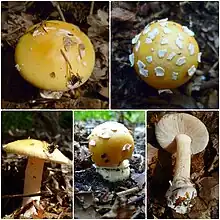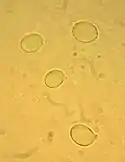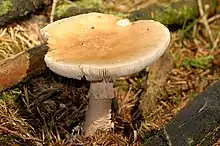Amanita gemmata
Amanita gemmata, commonly known as the gemmed amanita[4] or the jonquil amanita, is an agaric mushroom of the family Amanitaceae and genus Amanita. The fruit body has a cap that is a dull to golden shade of yellow, and typically 2.5–12 cm (1–4+3⁄4 in) in diameter. The cap surface is sticky when moist, and characterized by white warts, which are easily detached. It is initially convex, and flattens out when mature. The flesh is white and does not change colour when cut. The gills are white and closely spaced. The stem is pale yellow, and measures 4–12 cm (1+5⁄8–4+3⁄4 in) long by 0.5–1.9 cm (1⁄4–3⁄4 in) thick. The partial veil that covers the young fruit body turns into the ring on the stem at maturity. The spore print is white, while the spores are roughly elliptical, and measure 8–10 by 6.5–7.5 μm.
| Amanita gemmata | |
|---|---|
 | |
| In different stages of development | |
| Scientific classification | |
| Domain: | Eukaryota |
| Kingdom: | Fungi |
| Division: | Basidiomycota |
| Class: | Agaricomycetes |
| Order: | Agaricales |
| Family: | Amanitaceae |
| Genus: | Amanita |
| Species: | A. gemmata |
| Binomial name | |
| Amanita gemmata | |
| Synonyms | |
| |
| Amanita gemmata | |
|---|---|
| Gills on hymenium | |
| Cap is convex or flat | |
| Hymenium is adnate or adnexed | |
| Stipe has a ring | |
| Spore print is white | |
| Ecology is mycorrhizal | |
| Edibility is poisonous or psychoactive | |
This species is a mycorrhizal fungus, widespread in Europe. It can grow either singly, scattered, or in groups. It prefers habitats like coniferous and mixed forests and alongside paths, where it fruits in summer and fall. It is a toxic mushroom, containing ibotenic acid and muscimol, also found in many species in section Amanita of the Amanita genus including Amanita muscaria and A. pantherina. It is often confused with various other European species. A. gemmata resembles the false death cap, tawny grisette and panther cap mushrooms. Its cap is brighter in color than the former, and more yellow than the latter two.
Taxonomy and phylogeny
| |||||||||||||||||||||||||||||||||||||||||||||
| Phylogeny and relationships of A. gemmata and related species based on combined analyses of nLSU-DNA and mtSSU-DNA sequences.[5] |
The species was first described scientifically by Swedish mycologist and botanist Elias Magnus Fries as Agaricus gemmatus in 1838.[6] It was transferred to the genus Amanita in 1866 by the French statistician Louis Bertillon.[7] The species has been transferred to several genera in its history, resulting in a number of synonyms, including Amanita muscaria var. gemmata (1886, Lucien Quélet), Amanitopsis gemmata (1887, Pier Andrea Saccardo), Amanitaria gemmata (1940, Jean-Edouard Gilbert), and Venenarius gemmatus (1948, William Murrill).[1] Amanita authority Rodham E. Tulloss considers A. amici (published by Claude Casimir Gillet in 1891) to be synonymous with A. gemmata, as the macroscopic characteristics of the former fall within the limits of the range expected for the latter.[3]
Within the genus Amanita, A. gemmata is classified in subgenus Amanita, section Amanita, subsection Gemmatae, and series Gemmatae.[3] Tulloss places the species in a stirps (an informal ranking above species level) with A. russuloides and A. viscidolutea.[8] Some mycologists believe that A. gemmata is not different from A. russuloides.[9] Two molecular studies based on sequences of the large ribosomal subunit RNA gene (nLSU-rDNA) and the mitochondrial small ribosomal subunit RNA gene (mtSSU-rDNA) show that A. gemmata is part of a clade within Amanita with its close relatives A. muscaria, A. farinosa and A. roseitincta.[5][10]
The mushroom is commonly known as the "gemmed Amanita", the "jonquil Amanita",[11] or the "European gemmed Amanita".[3]
Description

The fruit bodies are colored yellow overall. The fresh cap, ranging in color from dull creamy yellow to golden yellow to buff, is sticky when moist. White warts adorn the cap surface, but they are usually flimsy and easily washed away by rain. They are placed randomly, but tend to be more concentrated in the center. The cap is typically 2.5–12 cm (1–4+3⁄4 in) in diameter, and initially convex before flattening out in maturity. The flesh is white, and shows no change when sliced.[12]
The gills are adnate to adnexed, and white; they are close together, with little intervening space. The pale yellowish stem is 4–12 cm (1+5⁄8–4+3⁄4 in) long by 0.5–1.9 cm (1⁄4–3⁄4 in) thick, and either roughly equal in width throughout, or slightly thicker at the base. Young mushrooms have a membranous partial veil extending from the upper stem to the cap margin; as the mushroom grows, the partial veil tears to leave a flimsy, skirt-like, easily lost ring on the stem. At the base of the stem is a white volva (a remnant of the universal veil that covered the immature mushroom) that usually forms a small, free rim. Spore prints are white.[11] There is no distinctive odour.[13]
Microscopic characteristics

Amanita gemmata has ellipsoid to broadly ellipsoid spores measuring 8–10 by 6.5–7.5 μm with an average Q-ratio (the fraction of length/width) of 1.35; they are not amyloid. The spores are smooth, thin-walled, and they contain one to several small oil droplets.[3] The basidia (spore-bearing cells of the hymenium) are usually four-spored, club shaped, and measure 30–40 by 8–11 μm.[12]
The gill tissue is divergent, meaning that the cells are more or less parallel near the center of the gill, but bend outwards near the end of the gill. The hyphae in this tissue are cylindrical to inflated, thin walled, hyaline (translucent) to yellowish, and measure 2.2–9 μm wide; the hyphae in the central strand are narrower and typically cylindrical. The hyphae of the subhymenium (a layer of tissue directly under the hymenium) are interwoven. These hyphae are branched, cylindrical to slightly inflated, hyaline, and 6–9 μm wide. The hyphae of the cap cuticle are filamentous, interwoven, and radially arranged. They are cylindrical, 2.7–4 μm wide, thin-walled, hyaline to yellowish, and gelatinize when mounted in potassium hydroxide. The cap tissue is also interwoven, with hyphae that are cylindrical to somewhat inflated, 3.7–14.6 μm wide, thin-walled, branched, and hyaline to yellowish. Caulocystidia are abundant on the apex of the stem; they are club-shaped to cylindrical, thin-walled, hyaline, and measure 3–9 μm wide. The annulus tissue comprises interwoven cylindrical hyphae measuring 3–9 μm wide. Sphaerocysts (inflated, spherical cells) are also present in the annulus tissue; they are club shaped to ellipsoidal, with dimensions of 29–55 by 30–70 μm. The warts on the cap surface (remnants of the universal veil) comprise loosely interwoven cylindrical to inflated thin-walled hyphae that are 3.5–8 μm wide. Sphaerocysts in this tissue are 58.5–70.2 by 17.5–40 μm, ellipsoidal, and hyaline. The volval tissue is interwoven, with cylindrical, hyaline hyphae that are 4.4–7.3 μm wide. The sphaerocysts here are ellipsoidal to roughly spherical, hyaline, and measure 35–70 by 20–35 μm. In A. gemmata, where they are most abundant in the region just below the cap cuticle, these refractive cells are scattered, and have a width of 3.7–6 μm. Clamp connections are rare in the hyphae of A. gemmata; they are present in the annulus, gill tissue, subhymenium, and cap tissue.[12]
Similar species
There are numerous species in North America that resemble A. gemmata.[14] In 2005, mycologist Rod Tulloss described Amanita aprica, a species that has been confused with A. gemmata several times in the past.[15] According to mycologists Pierre Neville and Serge Poumarat, the Mediterranean species A. amici (synonymous with A. gemmata f. amici)[16] is similar in appearance to A. gemmata but is larger. According to Tulloss however, their measurements of the cap and stem dimensions of A. amici fell within the range expected for A. gemmata, and for this reason, the two taxa should be considered conspecific.[3] Neville and Poumarat suggest that the name A. gemmata still persists for Mediterranean collections because of its frequent historical misapplication to the native Italian species A. gioiosa, which had not been described as a distinct species until 2004.[3] A. orientigemmata, a mushroom ranging from Japan to China, is a lookalike, but has clamps, unlike A. gemmata. Other differences between the two species include the slightly smaller spores of A. orientigemmata, and differences in the microstructure of the cap warts.[17]
Toxicity
Toxicity is suspected to be due to the presence of muscimol and ibotenic acid.[18]
Generally, symptoms of poisoning appear within three hours of ingestion of the mushroom as visual hallucinations, nausea, vomiting, stomach pain, diarrhea, irregular and slow heart beat and agitation. Severe cases involving coma, convulsions, or death are extremely rare.[19]
Ecology, habitat and distribution

Amanita gemmata is a mycorrhizal fungus, meaning it forms a mutually beneficial relationship with the roots of compatible host plants. Through the association, the plant provides the fungus with a carbon source, and the fungus provides the plant with several benefits such as nutrients and protection from pathogens. Largent and collaborators (1980) document mycorrhizal associations of A. gemmata with Manzanita (Arctostaphylos spp.) and Lodgepole Pine (Pinus contorta),[20] and Nieto and Carbone with Maritime Pine (Pinus pinaster) in Spain.[21] The fungus favours sandy and slightly acidic soils, and is often found in association with Norway Spruce (Picea abies). The mushroom grows either singly, scattered, or in groups in coniferous and mixed forests, especially along paths and roads.[11][22]
The species is distributed in areas of Asia and Europe. It is widely distributed (as a species cluster, not the actual Amanita gemmata) in North America,[11] where it has been found as far south as Ixtlán de Juárez, Mexico.[23] The species has been reported from the Dominican Republic.[24] In South America, it is known from Chile and Colombia.[25] In Asia, the mushroom has been collected from Iran[26] and China.[27]
See also
References
- "Amanita gemmata (Fr.) Bertill. 1866". MycoBank. International Mycological Association. Retrieved 2010-12-05.
- "Amanita gemmata (Fr.) Bertill". Species Fungorum. CAB International. Retrieved 2010-12-05.
- Tulloss, Rodham E. (2010). "Amanita gemmata". Amanitaceae.org – Taxonomy and Morphology of Amanita and Limacella. Retrieved 2012-06-21.
- "Standardized Common Names for Wild Species in Canada". National General Status Working Group. 2020.
- Moncalvo, Jean-Marc; Drehmel, Dennis; Vilgalys, Rytas (2000). "Variation in modes and rates of evolution in nuclear and mitochondrial ribosomal DNA in the mushroom genus Amanita (Agaricales, Basidiomycota): phylogenetic implications". Molecular Phylogenetics and Evolution. 16 (1): 48–63. doi:10.1006/mpev.2000.0782. PMID 10877939.
- Fries, Elias Magnus (1838). Epicrisis systematis mycologici: seu synopsis hymenomycetum (in Latin). Uppsala, Sweden: Typographia Academica. p. 12.
- Dechambre, Amédée (1866). Dictionnaire Encyclopédique des Sciences Médicales (in French). Vol. 1. Paris, France: Masson. pp. 491–511.
- Tulloss, Rodham E.; Yang, Zhu L. (2012). "stirps Gemmata". Amanitaceae.org – Taxonomy and Morphology of Amanita and Limacella. Retrieved 2012-06-21.
- Murrill, William A. (1913). "The Amanitas of Eastern North America". Mycologia. 5 (2): 72–86. doi:10.2307/3753566. JSTOR 3753566.
- Drehmel, Dennis; Moncalvo, Jean-Marc; Vilgalys, Rytas (1999). "Molecular phylogeny of Amanita based on large subunit ribosomal DNA sequences: implications for taxonomy and character evolution". Mycologia. 91 (4): 610–618. doi:10.2307/3761246. JSTOR 3761246.
- Arora, David (1986). Mushrooms Demystified: A Comprehensive Guide to the Fleshy Fungi. Berkeley, California: Ten Speed Press. p. 281. ISBN 978-0-89815-169-5.
- Ammirati, Joseph F.; Traquair, James A.; Horgen, Paul A. (1985). Poisonous Mushrooms of Canada: Including other Inedible Fungi. Markham, Ontario: Fitzhenry & Whiteside in cooperation with Agriculture Canada and the Canadian Government Publishing Centre, Supply and Services Canada. pp. 174–176. ISBN 978-0-88902-977-4.
- Kuo, Michael (March 2006). "Amanita gemmata species group". MushroomExpert.Com. Retrieved 2012-06-15.
- Bresinsky, Andreas; Besl, Helmut (1989). A Colour Atlas of Poisonous Fungi: A Handbook for Pharmacists, Doctors, and Biologists. London, UK: Manson Publishing. pp. 110–111. ISBN 978-0-7234-1576-3.
- Tulloss, Rodham E.; Lindgren, Janet E. (2005). "Amanita aprica—a new toxic species from western North America". Mycotaxon. 91: 193–205.
- "Amanita amici Gillet :t.2, 1891". MycoBank. International Mycological Association. Retrieved 2012-11-25.
- Tulloss, Rodham E. "Amanita orientigemmata". Amanitaceae.org. Retrieved 2012-10-26.
- Gilbert, John; Şenyuva, Hamide (2008). Bioactive Compounds in Foods. Oxford, UK: Blackwell Publishing. p. 119. ISBN 978-1-4051-5875-6.
- Russell, Alice B. (1997). "Amanita gemmata". Poisonous Plants of North Carolina. North Carolina State University. Archived from the original on 2013-10-03. Retrieved 2012-06-20.
- Largent, David L.; Sugihata, Neil; Brinitzer, Ann (1980). "Amanita gemmata, a non-host-specific mycorrhizal fungus of Arctostaphylos manzanita". Mycologia. 72 (2): 435–439. doi:10.2307/3759273. JSTOR 3759273.
- Nieto, Montserrat Pestaña; Carbone, Serena Santolamazza (2008). "Characterization of juvenile maritime pine (Pinus pinaster Ait.) ectomycorrhizal fungal community using morphotyping, direct sequencing and fruitbodies sampling". Mycorrhiza. 19 (2): 91–98. doi:10.1007/s00572-008-0207-0. PMID 18972139. S2CID 196602469.
- McKnight, Vera B.; McKnight, Kent H. (1987). A Field Guide to Mushrooms: North America. Peterson Field Guides. Boston, Massachusetts: Houghton Mifflin. pp. 225–226. ISBN 978-0-395-91090-0.
- Villanueva-Jimenez, Emmanuel; Villegas-Rios, Margarita; Cifuentes-Blanco, Joaquin; Leon-Avendano, Hugo (2006). "Diversity of the genus Amanita in two areas with different forestry management in Ixtlán de Juárez, Oaxaca, Mexico". Revista Mexicana de Biodiversidad (in Spanish). 77 (1): 17–22. ISSN 1870-3453.
- Gallart, C. Augusto Rodriguez (1997). "Study of micromycetes from the Dominican Republic: Part III". Moscosoa (in Spanish). 9: 145–153. ISSN 0254-6442.
- Sierralta, A.; Jeria, M.E.; Figueroa, G.; Pinto, J.; Araya, J.C.; San Juan, J.; Grinbergs, J.; Valenzuela, E. (1994). "Intoxicación por callampas venenosas en la IX Región. Rol de Amanita gemmata" [Mushroom Poisoning in the 9th region of Chile. Role of Amanita gemmata]. Revista Médica de Chile (in Spanish). 122 (7): 795–802. ISSN 0034-9887. PMID 7732230.
- Saber, M. (1995). "The species of Amanita in Iran". Iranian Journal of Plant Pathology (in Arabic). 31 (1–4): 15–18. ISSN 0006-2774.
- Zhishu, Bi; Zheng, Guoyang; Taihui, Li (1993). The Macrofungus Flora of China's Guangdong Province (Chinese University Press). New York, New York: Columbia University Press. p. 273. ISBN 978-962-201-556-2.
External links
 Data related to Amanita gemmata at Wikispecies
Data related to Amanita gemmata at Wikispecies Media related to Amanita gemmata at Wikimedia Commons
Media related to Amanita gemmata at Wikimedia Commons
